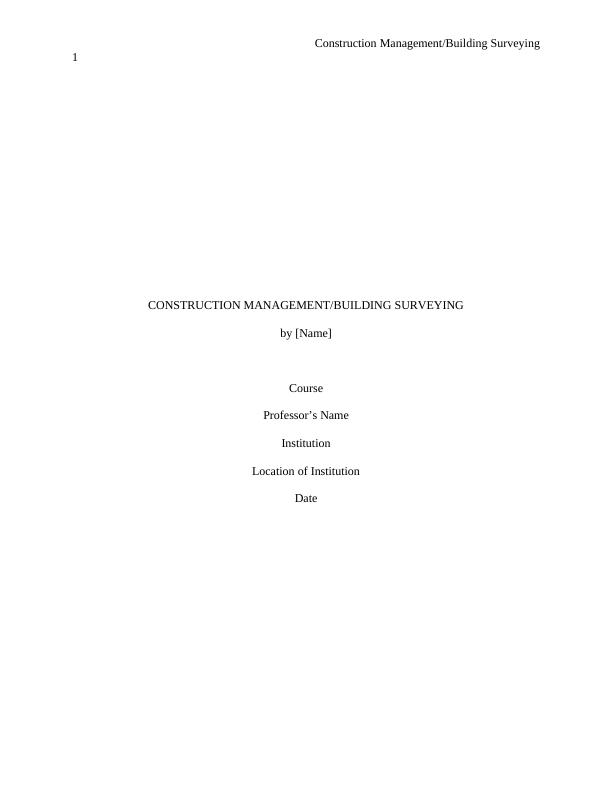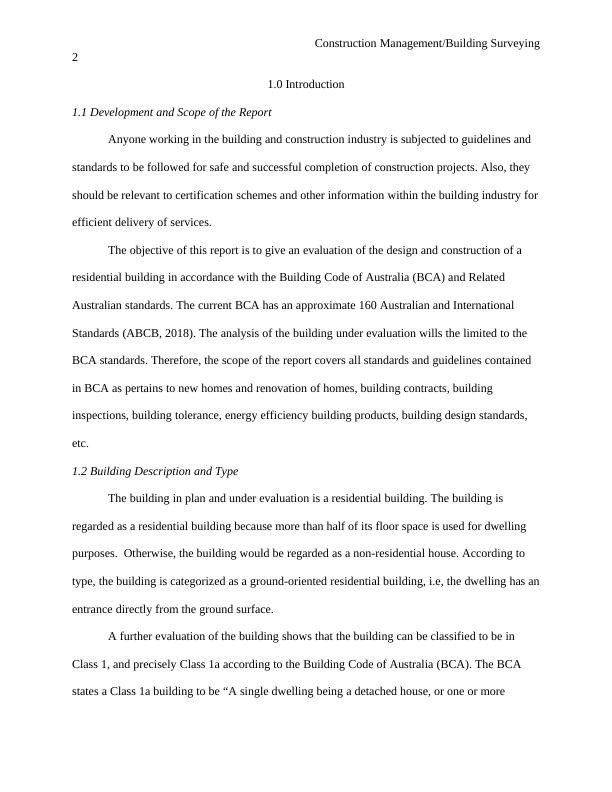Construction Management or Building Surveying
Added on 2021-06-14
13 Pages2996 Words14 Views
Construction Management/Building Surveying
1
CONSTRUCTION MANAGEMENT/BUILDING SURVEYING
by [Name]
Course
Professor’s Name
Institution
Location of Institution
Date
1
CONSTRUCTION MANAGEMENT/BUILDING SURVEYING
by [Name]
Course
Professor’s Name
Institution
Location of Institution
Date

Construction Management/Building Surveying
2
1.0 Introduction
1.1 Development and Scope of the Report
Anyone working in the building and construction industry is subjected to guidelines and
standards to be followed for safe and successful completion of construction projects. Also, they
should be relevant to certification schemes and other information within the building industry for
efficient delivery of services.
The objective of this report is to give an evaluation of the design and construction of a
residential building in accordance with the Building Code of Australia (BCA) and Related
Australian standards. The current BCA has an approximate 160 Australian and International
Standards (ABCB, 2018). The analysis of the building under evaluation wills the limited to the
BCA standards. Therefore, the scope of the report covers all standards and guidelines contained
in BCA as pertains to new homes and renovation of homes, building contracts, building
inspections, building tolerance, energy efficiency building products, building design standards,
etc.
1.2 Building Description and Type
The building in plan and under evaluation is a residential building. The building is
regarded as a residential building because more than half of its floor space is used for dwelling
purposes. Otherwise, the building would be regarded as a non-residential house. According to
type, the building is categorized as a ground-oriented residential building, i.e, the dwelling has an
entrance directly from the ground surface.
A further evaluation of the building shows that the building can be classified to be in
Class 1, and precisely Class 1a according to the Building Code of Australia (BCA). The BCA
states a Class 1a building to be “A single dwelling being a detached house, or one or more
2
1.0 Introduction
1.1 Development and Scope of the Report
Anyone working in the building and construction industry is subjected to guidelines and
standards to be followed for safe and successful completion of construction projects. Also, they
should be relevant to certification schemes and other information within the building industry for
efficient delivery of services.
The objective of this report is to give an evaluation of the design and construction of a
residential building in accordance with the Building Code of Australia (BCA) and Related
Australian standards. The current BCA has an approximate 160 Australian and International
Standards (ABCB, 2018). The analysis of the building under evaluation wills the limited to the
BCA standards. Therefore, the scope of the report covers all standards and guidelines contained
in BCA as pertains to new homes and renovation of homes, building contracts, building
inspections, building tolerance, energy efficiency building products, building design standards,
etc.
1.2 Building Description and Type
The building in plan and under evaluation is a residential building. The building is
regarded as a residential building because more than half of its floor space is used for dwelling
purposes. Otherwise, the building would be regarded as a non-residential house. According to
type, the building is categorized as a ground-oriented residential building, i.e, the dwelling has an
entrance directly from the ground surface.
A further evaluation of the building shows that the building can be classified to be in
Class 1, and precisely Class 1a according to the Building Code of Australia (BCA). The BCA
states a Class 1a building to be “A single dwelling being a detached house, or one or more

Construction Management/Building Surveying
3
attached dwellings, each being a building, separated by a fire-resisting wall, including a row
house, terrace house, town house or villa unit” (QUEENSLAND BUILDING AND
CONSTRUCTION COMMISSION, 2018). The building evaluated is a single dwelling residence
comprising of 3 bedroom units, the kitchen, dining, study rooms, garage and other common
essential units of a residential house.
Different materials are used for the construction of the various parts of the building. The
roof was constructed using metal roof sheeting on timber framings with an aluminum cover
panel, folded finish/color to match window frames. The walls are constructed using timber
battens mounted over timber studs – a lightweight cladding is put on the timber. The building
floor is made of a concrete slab on a compacted fill and footings. The floor extends to a timber
deck and it is insulated under the slab. A WP membrane and compacted sand to the BCA are put
beneath the slab. Other building components such as doors and windows are made of timber and
metal frames with fitted glass as per BCA.
1.3 Site Criteria Used to Asses the Building
The criterion used to assess the building is bushfire zone. A general view of the building
site shows that the structure is built at a bushfire prone area. A bushfire prone area is an area
which is subject to or likely subjected to bushfires. The building is located close to trees and
bushes, increasing chances of the building being exposed to fires in case they occur in the nearby
bushes. BCA outlines specific bushfire construction guidelines for some particular residential
buildings in “designated bush fire prone areas” objectively to minimize the ignition risk from a
bushfire. As stated before, the building is under is classified as Class 1a, and the BCA bush fire
construction requirements are inclusive of these class.
3
attached dwellings, each being a building, separated by a fire-resisting wall, including a row
house, terrace house, town house or villa unit” (QUEENSLAND BUILDING AND
CONSTRUCTION COMMISSION, 2018). The building evaluated is a single dwelling residence
comprising of 3 bedroom units, the kitchen, dining, study rooms, garage and other common
essential units of a residential house.
Different materials are used for the construction of the various parts of the building. The
roof was constructed using metal roof sheeting on timber framings with an aluminum cover
panel, folded finish/color to match window frames. The walls are constructed using timber
battens mounted over timber studs – a lightweight cladding is put on the timber. The building
floor is made of a concrete slab on a compacted fill and footings. The floor extends to a timber
deck and it is insulated under the slab. A WP membrane and compacted sand to the BCA are put
beneath the slab. Other building components such as doors and windows are made of timber and
metal frames with fitted glass as per BCA.
1.3 Site Criteria Used to Asses the Building
The criterion used to assess the building is bushfire zone. A general view of the building
site shows that the structure is built at a bushfire prone area. A bushfire prone area is an area
which is subject to or likely subjected to bushfires. The building is located close to trees and
bushes, increasing chances of the building being exposed to fires in case they occur in the nearby
bushes. BCA outlines specific bushfire construction guidelines for some particular residential
buildings in “designated bush fire prone areas” objectively to minimize the ignition risk from a
bushfire. As stated before, the building is under is classified as Class 1a, and the BCA bush fire
construction requirements are inclusive of these class.

Construction Management/Building Surveying
4
Following the Australian Standard AS 3959 – Construction of buildings in bushfr-prone
areas (2009, incorporating Amendments Nos 1, 2, and 3), the building can further be categorized
according to the Bush fire Attack Level (BAL) to be BAL-19 – Moderate risk. The classification
is based on the assessment of the building site – there is moderate to medium vegetation cover,
an indication of the building being in a fire prone area.
2.0 Alternative Design Solutions
2.1 Alternative Designs
According to Archicenter Australia, the risk to property and lives during a bushfire can
be reduced through architectural design principles (Hordov, 2018). Alternative designs for the
building to minimize bushfire risk are not but limited to siting, house design, construction
materials, and landscaping. Therefore, alternative design of the building will begin by a
clearance of the vegetation around the building. The building will also need to be kept away
from steep hillsides and ensuring there is enough cleared land between the house and the bushes
around. As far as the house design is concerned, the roof could be improved to be simpler with
uncomplicated layouts, window protection, and in-built water storage facilities. The house design
could also incorporate fire resistant materials and an installation of sprinkler systems (Lataille,
2002). Alternative design will also include various materials for various parts of the building.
The timber section of the floor should be sheeted underneath using a non-flammable material;
the construction can be done using a fire-retardant treated timber. The walls, windows, doors and
general ceiling and roofing material would be non-combustible. Lastly, as a part of alternative
design, landscaping could be done by planting tree species classified as bushfire-resistant; they
can also be used as wind breaks and barriers.
2.2 Design and Site Management Issues
4
Following the Australian Standard AS 3959 – Construction of buildings in bushfr-prone
areas (2009, incorporating Amendments Nos 1, 2, and 3), the building can further be categorized
according to the Bush fire Attack Level (BAL) to be BAL-19 – Moderate risk. The classification
is based on the assessment of the building site – there is moderate to medium vegetation cover,
an indication of the building being in a fire prone area.
2.0 Alternative Design Solutions
2.1 Alternative Designs
According to Archicenter Australia, the risk to property and lives during a bushfire can
be reduced through architectural design principles (Hordov, 2018). Alternative designs for the
building to minimize bushfire risk are not but limited to siting, house design, construction
materials, and landscaping. Therefore, alternative design of the building will begin by a
clearance of the vegetation around the building. The building will also need to be kept away
from steep hillsides and ensuring there is enough cleared land between the house and the bushes
around. As far as the house design is concerned, the roof could be improved to be simpler with
uncomplicated layouts, window protection, and in-built water storage facilities. The house design
could also incorporate fire resistant materials and an installation of sprinkler systems (Lataille,
2002). Alternative design will also include various materials for various parts of the building.
The timber section of the floor should be sheeted underneath using a non-flammable material;
the construction can be done using a fire-retardant treated timber. The walls, windows, doors and
general ceiling and roofing material would be non-combustible. Lastly, as a part of alternative
design, landscaping could be done by planting tree species classified as bushfire-resistant; they
can also be used as wind breaks and barriers.
2.2 Design and Site Management Issues

End of preview
Want to access all the pages? Upload your documents or become a member.
Related Documents
Residential Timber-Framed Construction: AS1684.4 Guidelineslg...
|12
|1774
|496
Construction IV in Building & Constructionlg...
|13
|1847
|174
Estimating Cost Advice for Scheme A and B | Deskliblg...
|10
|3829
|272
Floor Framing - AS1684.4lg...
|11
|1249
|47
Construction IV in Building & Construction - Floor Framing AS1684.4lg...
|10
|1193
|94
CPCCBC4010B Apply Structural Principles to Residential Lowlg...
|3
|653
|145
